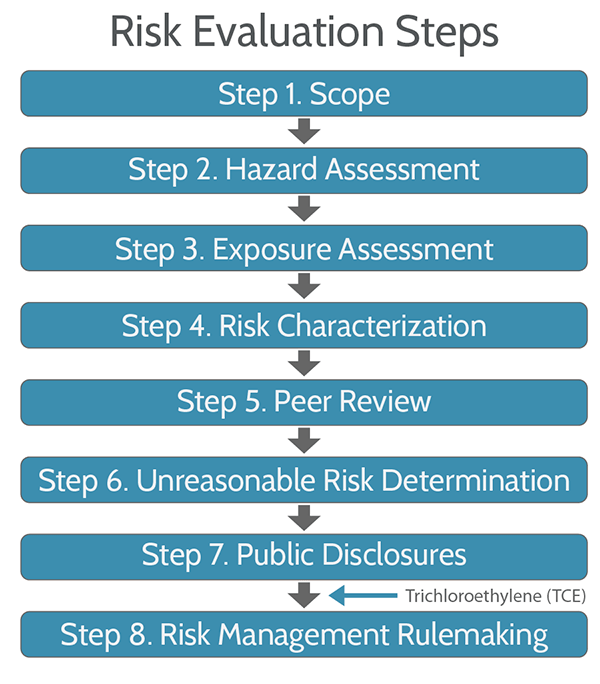On January 9, 2023, EPA announced the final trichloroethylene (also known as trichloroethene or TCE) regulatory determination declaring the substance as having an unreasonable risk of injury to human health for 52 out of 54 conditions of use (COUs). According to EPA, taking into consideration the November 2020 risk evaluation, public comments, peer review, and recent changes in policy, TCE poses unreasonable risks to the health of workers, non-users in close proximity to TCE, consumers, and bystanders.
TSCA subject: Trichloroethylene (CAS 79-01-6)
TCE is a volatile organic compound (VOC) used in industrial and commercial processes and can also be found in consumer products such as cleaning and furniture care products, automotive care products, and arts and crafts materials. TCE was one of the 10 substances prioritized for assessment under the Reformed (2016) Toxic Substances Control Act (TSCA) paradigm. Currently, most TCE on the market is used as a feedstock in refrigerants production. Smaller amounts are used as a degreasing solvent. Because of its past uses, TCE may be found at certain contaminated sites, most commonly in groundwater near former industrial degreasing operations, improperly disposed industrial waste locations, and old dry cleaning shops.
Regulatory action: Unreasonable risk determination
EPA’s unreasonable risk determination for TCE is driven by risks related to the following generalized COUs:
- Manufacturing (including import)
- Processing as a reactant/intermediate, and into a chemical formulation and manufactured articles
- Repackaging and recycling
- Industrial and commercial use as a solvent, in adhesives and sealants, lubricants and greases, functional fluids, paints and coating, and in a variety of cleaning products
- Commercial and consumer use in several products
- Disposal
Details on specific COUs are provided in EPA’s supporting documents.
Scientific basis: Immune system effects via inhalation and transdermal uptake
While EPA cites multiple adverse effects (i.e., developmental toxicity, reproductive toxicity, liver toxicity, kidney toxicity, neurotoxicity, and cancer), key endpoints supporting its determination were associated with immune system effects from acute and chronic inhalation as well as dermal exposure.
Key changes: “Whole chemical substance” approach is in, PPE assumptions are out
EPA’s announcement supersedes the 2020 TCE regulatory determination and affirms the new policy of not considering Occupational Health and Safety Administration (OSHA) personal protective equipment (PPE) requirements in risk evaluation. As a baseline in its new approach to risk determination, EPA no longer assumes the use of PPE as there may be use cases where PPE is not present. Unlike previous risk evaluations, EPA’s change in PPE policy resulted in the “whole chemical substance (WCS)” risk determination. Previously, EPA based its risk evaluation on separate COUs while considering OSHA-required respiratory, dermal, and other relevant exposure control measures. Under the WCS approach, if most of the COUs are found to pose an unreasonable risk, EPA may determine that the whole chemical presents unreasonable risk. The agency acknowledged the enhanced conservatism in the WCS approach and indicated that these important de facto exposure controls will be considered in the risk management phase.
Impacts: What EPA’s TCE risk determination means for operations
The unreasonable risk determination for TCE will likely lead to further pressure on users, distributors, manufacturers, and importers to eliminate the substance from their inventories. Applications that cannot eliminate TCE or find a suitable replacement will likely be subject to controls reducing the permitted amounts, PPE requirements, and/or other exposure controls.
EPA’s next steps: Risk management rulemaking
EPA will now create a risk management rulemaking to address risks, which will involve identifying and implementing risk management measures. TSCA’s authorities include the ability to place limitations on activities associated with manufacturing, import, use, processing, distribution, and disposal. EPA also plans to expand its evaluation to incorporate surface water, drinking water, and ambient air pathways for TCE not included in the 2020 assessment. The public will have an opportunity to comment on a proposed rule before EPA issues a final rule.

Figure 1. There are eight steps in the TSCA risk evaluation process; TCE is currently moving into the final step, risk management rulemaking.
Contact us
Our regulatory specialists remain up to date with TSCA and routinely support clients across industries with site-specific compliance. If you are interested in learning more about TSCA or how the latest regulatory developments affect your operations, read up on our past TSCA articles or connect with us using the form linked below.